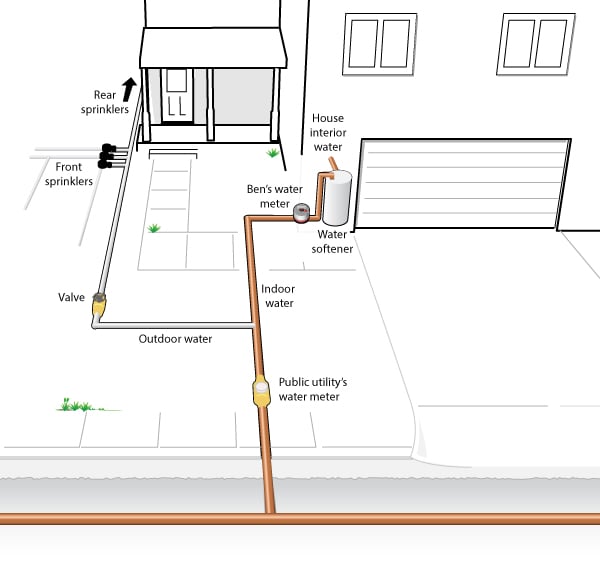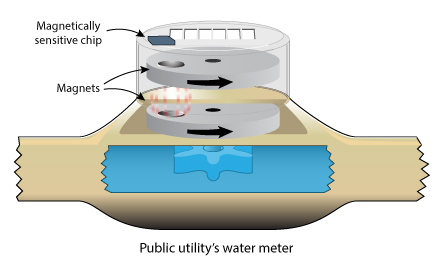Monitoring the water mains:
As mentioned in my blog last week, it was not until I monitored my water usage that I found out I was not monitoring ALL of my water usage.
My whole house water meter was just that, the whole house. It did not show any of the garden/lawn water use.
Let's talk about how we might get that data and what it could mean for conserving water in all aspects of our lives.
Where is the water main meter:
Just to refresh your memory, here's the diagram of how my water main is laid out on my property.

The challenge is pretty clear: I need to get data from the main water meter into my Opto system so I can see ALL our water usage in groov.
Yes, I could dig a hole around the sprinkler feed pipe, put an underground box in place and put another of the water meters I have monitoring the house in that box, and thus pick up the total information that way.
I always try to have a bigger picture in mind each time I do a personal project using Opto and groov. If I find it helpful, there is a good chance that someone somewhere else will also find it helpful.... In that light, yes, I could dig a hole, but the main's meter is already there, pretty much everyone has one, why not tap into it?
Not only that, but also the meter I bought only has a resolution of one pulse per gallon. It's pretty coarse. (But hey, it only cost me about 100 bucks, so you get what you pay for.) I know for a fact that the city-supplied water meter has a lot (lot) finer resolution than that!
I would really like to be able to see and know if I have a slow leak anywhere on my property. At one pulse per gallon, I might miss a slow leak in the day-to-day noise of the bulk of our water use.
The way I see it, there are two challenges to getting this data.
1. Getting the data out of the meter.
2. Getting the data from the meter to my garage.
Getting data from the meter.
When I first looked at the meter, I did not understand how it worked and so that held me up for a while. Long story short, the meter body is brass, and it is magnetically coupled from the impeller to the meter. Here a diagram really is worth a thousand words......

(I am so grateful for the fantastic illustrations that our graphic artist does for me here at Opto. Love ya work, John, thanks a heap!)
The magnet in the valve body and the magnet in the meter align and track each other. As the water flows, the impeller turns and the meter counts those turns. Brilliantly simple. There is no shaft coming through the valve body, so there is no chance of a seal ever leaking.
Our meter is electronically read via a small transmitter and a mesh network. So no one comes and opens the meter box. The lid is a bit overgrown with grass, but still visible just beside the sidewalk (footpath Downunder).
Getting data from the meter to the garage.
The breakthough came when I was trolling through one of my favorite websites: https://hackaday.io There are a bunch of cool projects on this site and I could spend days there looking them over and making a to-build list a mile long.... But the one that really caught my eye was this one from John Schuch: Remote Water Consumption Display.
Right here is pretty much the exact project I was looking for! (Except I don't need the display in the house, since we have Opto and groov for that.)
Using a cell phone magnetometer to pick up the pulses from the meter and then a small solar-powered transmitter to send them to the garage/house. Beautiful.
Sadly John has not made much progress on the project over the past few months. Life can get busy—something we all understand. The cool thing is that he has open-sourced the whole show, so we can pick it up and run with it.
This is the plan, but why am I so very excited about getting the data into my Opto system? Remember, I have my irrigation system automated by Opto, so having the flow rate data also in Opto will allow me to cut some code that can automatically detect a leaking system!
Think about that for a moment. Opto will turn on a zone and will know the typical flow rate for that zone. If it is beyond a reasonable limit for that zone, Opto will be able to turn that zone off straightaway and send me (or my wife) an email telling me that there is something wrong with that zone. If we don't get to it that day, it simply won't turn that zone on again the next.
Automatic water conservation. That's pretty cool.
CONCLUSION:
groov connects my family to my water usage.
Opto connects my irrigation system to allow us very fine and easy control.
Opto then connects the water main meter to all those other systems.
Connecting to the water meter and getting our whole property water usage data is the key to closing the loop.
Subscribe to this blog to be kept up to date with progress on this sensor/transmitter project as we implement it at my house—and a few other co-workers have expressed a huge interest as well....
Till next time, Cheers Mate.
